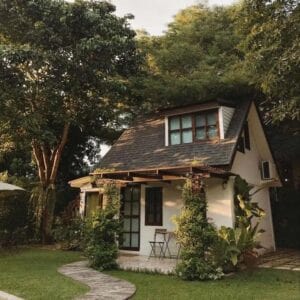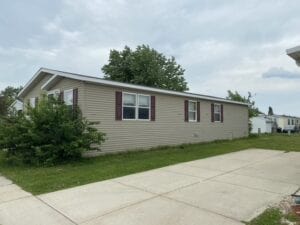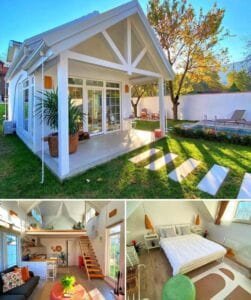Tiny homes and mobile homes are two popular alternatives to traditional houses. While both offer unique advantages, they cater to different lifestyles and preferences. Are you torn between the freedom of a mobile home and the compact charm of a tiny home? Let’s dive into the details.

Tiny House vs. Mobile Home: Which is Cheaper
In simple terms, tiny homes are small, self-contained dwellings typically ranging from 100 to 400 square feet. On the other hand, mobile homes are prefabricated structures designed for transportation, resembling traditional RVs.
Both options have been gaining momentum in recent years due to their affordability and flexibility. However, they attract distinct communities with different priorities. For some, the minimalist lifestyle offered by tiny homes is appealing, while others prefer the mobility and convenience associated with mobile homes.
When deciding between these alternatives, it’s essential to consider factors such as cost, location flexibility, personal space requirements, and long-term plans. By understanding the characteristics of each option, you can make an informed choice that aligns with your needs and aspirations.
So let’s explore further into the world of tiny homes versus mobile homes!
Key Distinctions: Tiny House vs Mobile Home
Building Materials Used in Construction
One of the key distinctions between mobile homes and tiny houses lies in the materials used for construction. Mobile homes, also known as manufactured homes, are typically constructed using lighter materials such as aluminum or vinyl siding, while tiny houses often utilize traditional building materials like wood and concrete.
Mobile home construction follows specific building codes set by the Department of Housing and Urban Development (HUD). These codes ensure that mobile homes meet safety standards and structural requirements. On the other hand, tiny houses are not subject to these regulations, allowing for more flexibility in material choices.
Size Limitations and Design Flexibility
Mobile homes tend to offer more interior space compared to tiny houses. Mobile homes are designed with larger square footage in mind, providing ample living areas for families. In contrast, tiny houses are intentionally compact and focus on maximizing functionality within a smaller footprint.
Despite their limited size, tiny houses offer remarkable design flexibility. They can be customized according to individual preferences and needs. From multi-functional furniture to clever storage solutions, every inch of a tiny house can be optimized for efficient living.
Mobility and Portability Features of Mobile Homes
The mobility factor is where mobile homes truly shine. As the name suggests, they are specifically designed to be easily moved from one location to another. Mobile home owners have the freedom to relocate whenever they desire or need to due to various circumstances such as job changes or personal preferences.
Mobile homes feature built-in wheels or axles that allow them to be transported without much hassle. They often come with towing hitches or detachable frames for easy transportation. This mobility aspect sets mobile homes apart from their tiny house counterparts.
Customization Options for Tiny Houses
While mobile homes excel in mobility, tiny houses offer unparalleled customization options. Tiny house enthusiasts embrace the opportunity to personalize their living spaces according to their unique tastes and requirements. From exterior finishes to interior layouts, the possibilities are endless.
Owners of tiny houses can freely choose from a wide range of customization options, including:
-
Exterior cladding materials (wood siding, metal panels, etc.)
-
Roofing styles (gabled, flat, shed)
-
Interior finishes (hardwood flooring, tile, etc.)
-
Kitchen appliances and fixtures
-
Bathroom fixtures and features
This level of customization allows individuals to create a truly personalized living space that reflects their personality and lifestyle.

Cost Comparison: Tiny Home vs Mobile Home
Initial purchase cost for both options
There is a significant difference between tiny homes and mobile homes. Tiny homes are often more affordable compared to mobile homes. On average, a tiny home can cost anywhere from $20,000 to $100,000 depending on the size and customization. In contrast, mobile homes typically range from $30,000 to $150,000.
While both options offer relatively lower costs compared to traditional houses, the price range for tiny homes tends to be more accessible for those on a tight budget. This affordability factor has contributed to the growing popularity of tiny homes among individuals seeking an alternative housing solution.
Long-term expenses, including maintenance and utilities
When considering long-term expenses such as maintenance and utilities, it’s important to evaluate how these costs may differ between tiny homes and mobile homes. While tiny homes are generally smaller in size and require less maintenance overall, they may have higher utility costs due to limited space efficiency.

On the other hand, mobile homes typically require regular maintenance similar to that of traditional houses. This includes upkeep of plumbing systems, electrical wiring, and structural integrity. However, due to their larger size compared to tiny homes, mobile home owners might experience higher utility bills as well.
It’s worth noting that energy-efficient features can help minimize utility expenses in both types of dwellings. For example, installing solar panels or using energy-saving appliances can significantly reduce electricity consumption in a tiny home or a mobile home.
Read more on our article: Solar Panels for Mobile Homes
Potential savings on property taxes with a tiny home
One advantage of owning a tiny home is the potential savings on property taxes. Since these dwellings have smaller footprints compared to conventional houses or even mobile homes in some cases, property taxes tend to be lower as well.
Property tax rates vary by location; however, many jurisdictions base their calculations on factors such as square footage and assessed property value. With a smaller living space, tiny home owners may enjoy reduced property tax obligations, providing them with additional financial flexibility.
Resale value considerations for mobile homes
Mobile homes have some unique factors to consider. Unlike traditional houses or tiny homes, which are often built on permanent foundations, mobile homes can be relocated more easily due to their design and construction.
While this mobility offers flexibility for homeowners who may desire a change of scenery, it can also impact the resale value of mobile homes. Potential buyers may be hesitant to invest in a structure that can be moved at any time. However, if well-maintained and located in desirable areas with access to amenities such as schools and shopping centers, mobile homes can still retain their value and attract interested buyers.
Financing Options: Choosing Between a Tiny House vs. Mobile Home
Availability of loans and financing programs for mobile homes
Mobile homes have long been recognized as an attractive option for those seeking a more affordable housing solution. One of the advantages of mobile homes is the availability of various loans and financing programs specifically designed for this type of dwelling. Traditional lenders, such as banks and credit unions, often offer mortgage options tailored to mobile homes. These loans typically come with competitive interest rates and flexible repayment terms.

In addition to traditional lenders, there are specialized financing companies that focus solely on mobile home financing. These companies understand the unique challenges and requirements associated with purchasing a mobile home, making them a reliable source for securing funding. They may offer additional benefits like streamlined application processes and faster approval times.
Challenges in obtaining financing for tiny houses
While mobile homes enjoy a range of financing options, the same cannot be said for tiny houses. Financing a tiny house can present several challenges due to their unconventional nature. Tiny houses are often built on trailers or foundations not recognized by traditional lenders as permanent structures, making it difficult to qualify for mortgage loans.
Furthermore, the relatively new concept of tiny living means there is limited data on resale values and market demand. This lack of information makes lenders hesitant to provide loans for these dwellings. Without established guidelines, potential homeowners must explore alternative avenues to finance their tiny house dreams.
Lease-to-buy or rent-to-buy options for mobile homes
For individuals considering a mobile home purchase but facing difficulty obtaining traditional financing, lease-to-buy or rent-to-buy options can be viable alternatives. These arrangements allow prospective buyers to lease or rent a mobile home with the option to purchase it at a later date.
Lease-to-buy agreements typically involve paying monthly rent along with an additional amount that goes towards building equity in the property over time. This option provides an opportunity to save money while enjoying the benefits of living in a mobile home before committing to ownership.
Rent-to-buy options, on the other hand, function similarly to lease-to-buy agreements but with a more flexible structure. Rent payments contribute towards the purchase price, and the buyer has the option to buy the mobile home within a specified timeframe. This arrangement allows individuals to test out mobile home living without making an immediate financial commitment.
Read more on our article: Renting a Mobile Home
Creative funding solutions like crowdfunding for tiny house projects
In light of the challenges associated with financing tiny houses, some individuals have turned to creative funding solutions like crowdfunding. Crowdfunding platforms provide a space for people to pitch their tiny house projects and seek financial support from interested individuals or organizations.
By showcasing their innovative designs and explaining how tiny living can offer financial freedom and reduced costs, proponents of tiny houses can attract backers who believe in their vision. Crowdfunding not only helps raise funds but also generates awareness about the benefits of tiny homes as a viable housing alternative.

Safety Considerations: Parked on Land
Zoning regulations and building codes for both types of dwellings
One important safety consideration is the zoning regulations and building codes that apply to each type of dwelling.
For tiny homes, these regulations can vary significantly depending on the location. Some areas may have specific requirements for minimum square footage, while others may restrict where tiny homes can be parked or prohibit them altogether. It’s crucial to research local zoning laws and obtain any necessary permits before setting up a tiny home.
On the other hand, mobile homes are subject to federal safety standards set by the Department of Housing and Urban Development (HUD). These standards cover various aspects such as construction materials, insulation, electrical systems, plumbing, and fire safety measures. Mobile homes must comply with these standards to ensure they meet minimum safety requirements.
Insurance requirements and coverage differences
Insurance is another aspect that should not be overlooked when considering the safety of both tiny homes and mobile homes. The insurance requirements and coverage options can differ between the two.
Tiny homes often fall into a gray area. Since they are relatively new in terms of housing options, finding suitable insurance policies can be challenging. Some insurers may treat them as recreational vehicles (RVs), while others may consider them similar to traditional houses. It’s essential for owners of tiny homes to explore their insurance options thoroughly and find coverage that adequately protects their investment.
Mobile homes typically require specialized insurance policies designed specifically for this type of dwelling. These policies take into account factors such as the age of the home, its location, and any additional structures attached to it. Mobile home insurance provides coverage for risks like fire damage, theft, liability claims from accidents occurring on your property, among others.
Fire safety precautions specific to mobile homes
Fire safety is a crucial consideration when comparing tiny homes versus mobile homes, particularly for the latter. Mobile homes have specific fire safety precautions in place due to their construction and materials.
To enhance fire safety in mobile homes, the National Fire Protection Association (NFPA) has developed guidelines that include requirements for smoke alarms, escape plans, and fire-resistant materials. Mobile home owners should ensure they have working smoke alarms installed according to NFPA standards and regularly test them.
It’s important to be aware of potential fire hazards such as faulty electrical systems or improper use of heating sources. Regular maintenance and inspections are necessary to identify and address any issues promptly. Taking precautions like keeping flammable materials away from heat sources and having an accessible fire extinguisher can further mitigate the risk of fires in mobile homes.
Relocation Costs: Tiny House vs. Mobile Home
Transportation costs involved in moving a mobile home
Transportation costs can be a significant factor to consider when deciding between a mobile home and a tiny home. Mobile homes, being larger and heavier structures, require specialized equipment and professional movers to transport them from one location to another. The cost of hiring such services can vary depending on the distance, size, and complexity of the move.
Moving a mobile home typically involves hiring a company that specializes in transporting these structures. They will assess the dimensions of your mobile home and determine the appropriate equipment needed for transportation. This may include flatbed trailers, hydraulic systems, or even cranes in some cases. The cost of renting or hiring this equipment can add up quickly.
In addition to equipment expenses, there are also considerations for permits and escorts during transportation. Many states require permits for moving oversized loads like mobile homes on public roads. These permits come with fees that can range from a few hundred dollars to several thousand dollars depending on the distance traveled.
Ease of relocating a tiny house compared to a mobile home
One advantage that tiny homes have over mobile homes is their ease of relocation. Due to their smaller size and lighter weight, tiny houses are generally easier to move than their larger counterparts. In many cases, individuals who own tiny homes opt for towing them using their own vehicles or hiring standard towing services instead of specialized movers.
The process of relocating a tiny house typically involves hitching it onto an appropriate trailer and driving it to the desired location. This simplicity not only saves money but also provides more flexibility.
Permits and legal considerations when moving either option
Both mobile homes and tiny houses require certain permits and legal considerations when being moved from one place to another. However, the specific requirements can vary depending on local regulations.
Mobile homes are subject to more stringent regulations due to their size and classification as permanent structures. Moving a mobile home often requires obtaining permits from local authorities, ensuring compliance with building codes, and coordinating with utility companies to disconnect and reconnect services.
On the other hand, tiny houses are generally classified as recreational vehicles or temporary structures in many jurisdictions. This classification can make it easier to relocate them without the need for extensive permits or legal complications. However, it is still important to research and adhere to local regulations to avoid any potential issues.
Impact on the overall cost when considering relocation
When comparing the overall cost of relocating a mobile home versus a tiny house, there are several factors to consider. The transportation costs involved in moving a mobile home can be substantial, including equipment rental, professional movers’ fees, permits, and escorts. These expenses can quickly add up and significantly impact your budget.
In contrast, relocating a tiny house tends to be more cost-effective due to its smaller size and simpler transportation requirements. Towing services or using your own vehicle may be sufficient for moving a tiny house, resulting in lower transportation costs overall.
Furthermore, the ease of relocation for tiny houses allows for greater flexibility in choosing affordable land options or taking advantage of travel opportunities by joining programs like Costco Travel that offer discounted accommodations suitable for tiny homes.
Living with Less Space: Tiny Home Lifestyle
Innovative Storage Solutions in Tiny Houses
One of the most remarkable aspects of tiny home living is the ingenious use of space through innovative storage solutions. With limited square footage, every nook and cranny becomes valuable real estate for homeowners to maximize their living area. From hidden compartments under staircases to built-in shelving units that double as room dividers, tiny houses are a testament to human creativity.
In a regular home, it’s easy to accumulate belongings over time, often resulting in cluttered spaces. However, tiny homes force individuals to be intentional about their possessions. This minimalist approach encourages individuals to carefully curate their belongings and prioritize only what truly adds value to their lives. By adopting this mindset, homeowners can enjoy a clutter-free environment while still having access to all the essentials.
Minimalist Living Benefits and Challenges
Living in a tiny house offers numerous benefits beyond just saving on square footage. The tiny house movement has gained popularity due to its potential for financial freedom and reduced environmental impact. With lower costs associated with housing and utilities, homeowners can allocate their resources towards experiences rather than mortgage payments.
However, embracing the tiny home lifestyle also comes with its fair share of challenges. Limited space means making sacrifices. While some may find this liberating, others may struggle with adjusting to a smaller kitchen or bathroom area. Hosting guests or accommodating growing families can pose logistical difficulties in such tight quarters.
Psychological Impact of Downsizing on Occupants
Downsizing from a traditional home to a tiny house can have profound psychological effects on occupants. It requires individuals to reevaluate their relationship with material possessions and redefine what truly brings them happiness and fulfillment. While some may initially feel overwhelmed by the process of letting go, many find that shedding unnecessary belongings leads to increased mental clarity and overall well-being.
Living in close proximity to loved ones in a tiny home can foster stronger relationships and create a sense of community. The shared space encourages frequent interactions and quality time spent together. However, it’s important for occupants to establish boundaries and find personal moments of solitude within the limited square footage.
Design Principles that Maximize Space Utilization
Designing a functional tiny home involves careful consideration of every inch of available space. Architects and homeowners alike employ various design principles to maximize utilization without compromising comfort. Some strategies include:
Multifunctional furniture: Incorporating pieces that serve multiple purposes, such as sofa beds or dining tables with built-in storage.
Lofted sleeping areas: Utilizing vertical space by creating lofted sleeping quarters, freeing up valuable floor area for other activities.
Open floor plans: Removing unnecessary walls and barriers to create an open layout that visually expands the living space.
Natural light optimization: Incorporating large windows and skylights to make the interior feel more spacious and connected with nature.
By implementing these design principles, tiny homes can offer a surprisingly comfortable living experience despite their compact size.
Living with less space in a tiny home or mobile home presents unique challenges and rewards. From innovative storage solutions to the psychological impact of downsizing, individuals who embrace this lifestyle discover the freedom that comes with minimalism. By carefully designing their spaces and adopting resourceful habits, homeowners can create cozy dwellings that prioritize experiences over material possessions while fostering strong connections with their communities.
Making the Choice Between a Tiny House vs. Mobile Home
In conclusion, when deciding between a tiny home and a mobile home, there are several key factors to consider. Understanding the distinctions between these two housing options is essential in making an informed decision.
Firstly, it is important to recognize that tiny homes and mobile homes have different characteristics. Tiny homes are typically smaller in size and often built on foundations, while mobile homes are larger and designed for mobility. This distinction impacts various aspects such as cost, financing options, safety considerations, relocation costs, and the overall lifestyle.
Cost comparison is another crucial aspect to consider. Tiny homes tend to be more affordable upfront due to their smaller size and simpler construction. However, ongoing expenses for maintenance and utilities may vary. On the other hand, mobile homes generally have higher initial costs but offer lower monthly expenses.
Tiny Homes Different Possibilities
Both tiny homes and mobile homes have different possibilities available. Depending on your financial situation and preferences, you can explore various loan options or even self-funding for either choice.
Safety considerations differ depending on whether your home will be parked on land or constantly moving. Parked tiny homes can provide stability and security while allowing you to customize your surroundings. Mobile homes require additional precautions during transportation but offer flexibility in terms of location changes.
Relocation costs play a significant role if you anticipate moving frequently. Mobile homes allow for easier relocation but involve expenses such as permits, transportation fees, and potential setup costs at each new location. Tiny houses can also be moved but may require more effort due to their foundation-based construction.
Living with less space is a fundamental aspect of the tiny home lifestyle. It requires embracing minimalism and making efficient use of every square inch available in your dwelling. This lifestyle choice promotes simplicity, sustainability, and conscious consumption.
Tiny House vs. Mobile Home: Conclusion
To make an informed decision about whether a tiny home or a mobile home suits your needs best, carefully consider these key points discussed above according to your personal circumstances, preferences, and long-term goals. Ultimately, the choice between a tiny home and a mobile home depends on your individual lifestyle, financial situation, and priorities.
FAQs: Tiny House vs. Mobile Home
1. Can I finance a tiny home or mobile home purchase?
Yes, financing options are available for both tiny homes and mobile homes. You can explore various loan options from banks or credit unions to finance your purchase.
2. Are there any safety concerns with living in a mobile home?
Living in a mobile home does come with potential safety considerations during transportation. However, once properly set up on land, mobile homes can provide a safe living environment.
3. How much does it cost to relocate a mobile home?
Relocation costs for mobile homes can vary depending on factors such as distance, permits required, transportation fees, and setup costs at the new location. It is advisable to research these expenses beforehand.
4. Is it possible to customize the interior of a tiny home?
Yes, one of the advantages of tiny homes is that they can be customized according to personal preferences and needs. You have the freedom to design and decorate your space creatively.
5. Do tiny homes require less maintenance than mobile homes?
Tiny homes generally require less maintenance compared to larger structures like mobile homes due to their smaller size. However, regular upkeep is still necessary to ensure their longevity and functionality.
These frequently asked questions address some common concerns when considering either a tiny home or a mobile home as your housing option. Remember to evaluate your specific requirements before making a decision that aligns with your lifestyle and goals.
You might also be interested in our articles:

